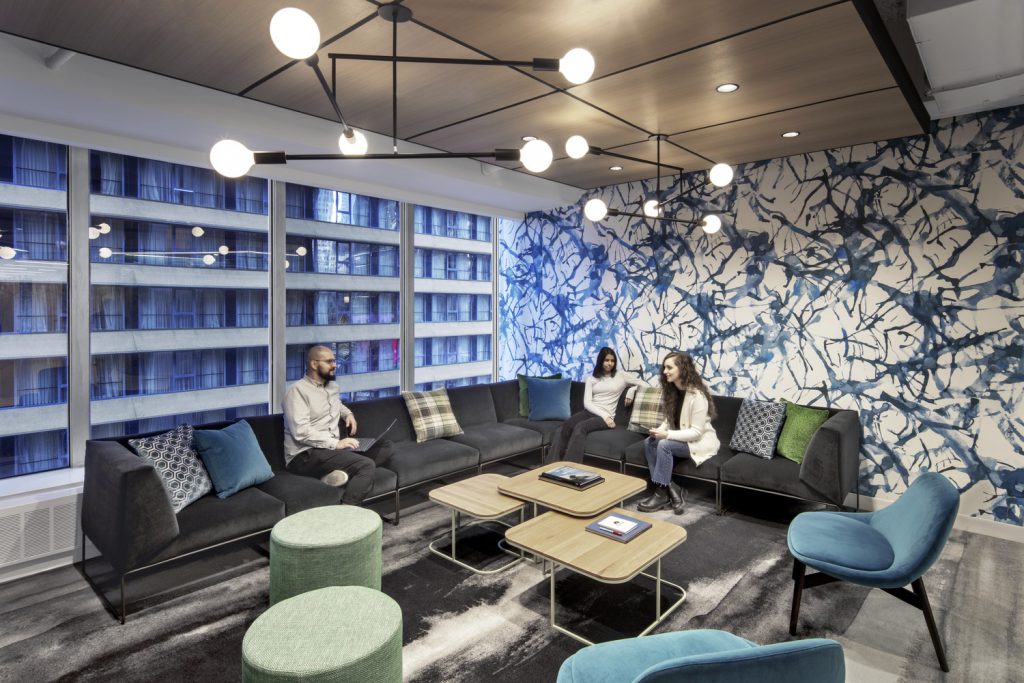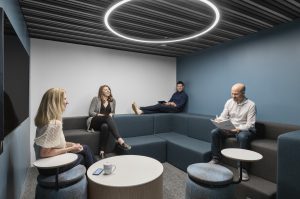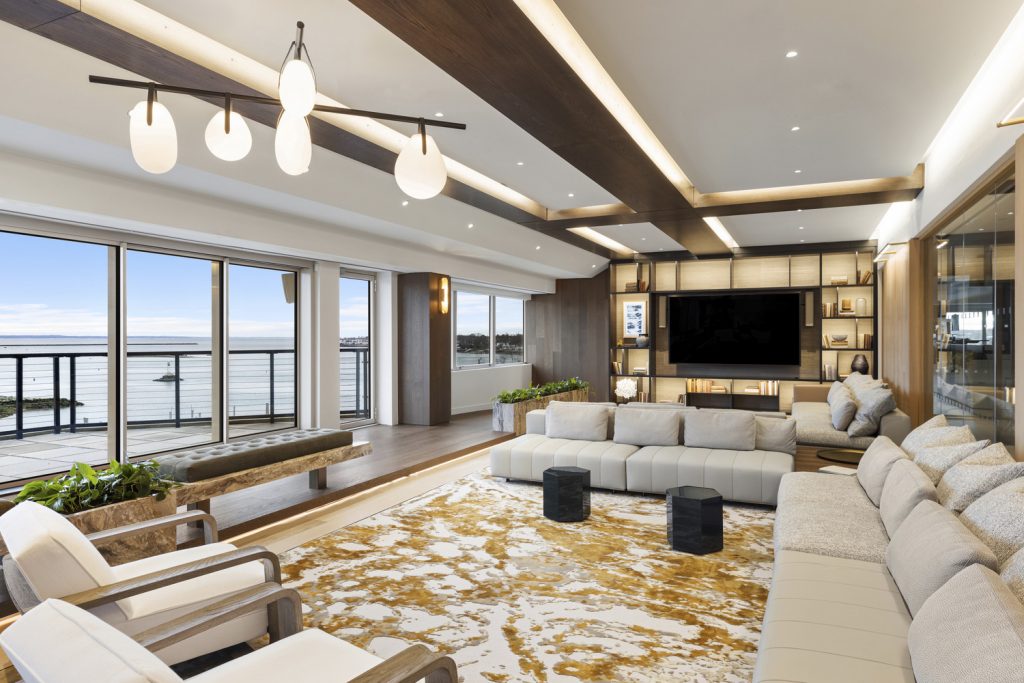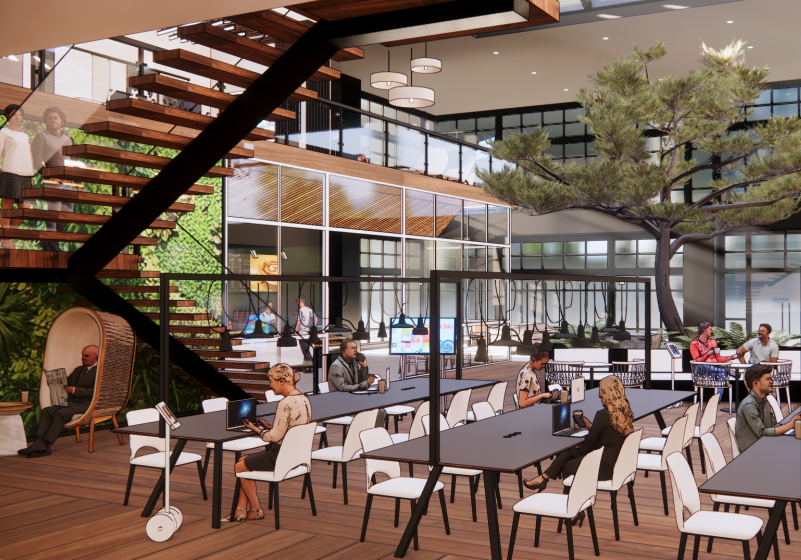Are you ready to embrace the future of meetings? Nicole Zack of Ted Moudis Associates talks designing workspaces that not only boost productivity but also prioritize well-being and satisfaction.
In an era where technology seamlessly integrates with daily life, the concept of the static meeting room could be rendered obsolete in the workplace. This transition is a signal of broader shifts in workplace dynamics, one that recognizes the diverse needs and wants of today’s workforce. Utilizing wearable technology, AI concierge services, and intuitive smart building environmental controls, we are equipped to design bespoke collaborative spaces that will adapt to occupant needs.
The future of meetings is not solely about facilitating communication; it’s about designing spaces that actively contribute to our well-being and enhance productivity.
Static Conferencing: A Relic of the Past
Currently, conference rooms are generally static environments where participants must adapt to their surroundings, as opposed to entering a space that evolves to their needs. In a time where technology integrates with daily life, where is the advancement in meeting spaces? Common issues of inadequate lighting- too bright, glares, flickering; uncomfortable fluctuating temperatures- always too hot, too cold, stuffy; and dated technology – “Hello? Can you hear us?, Can you see my screen?” often derail meetings before they even begin. The ritual of adjusting the room to accommodate the meeting’s needs—for a brainstorming session, a formal presentation, or a casual check-in—has become a time-consuming and often frustrating occurrence to kick off each meeting.

Intuitive Conferencing: Transforming the Future (A ENFP, ISFJ, INFP walk into a room…)
Now, imagine a future where the conference room will sense your arrival and instantaneously create an environment tailored to the meeting’s agenda, the anticipated supporting content suddenly displays on the screens and virtual participants are welcomed in just as the meeting starts. The spaces smart system integrator has factored in that there is a variety of personalities among the attendees joining. By leveraging this data from the work profiles of the individuals in the room, the AI room assistant, let’s call them “Work-dash,” will adjust the lighting, temperature, and even the artwork on the walls to match the optimal user preferences. Work-dash begins to transcribe meeting minutes and analyze key takeaways and sentiments from the meeting. Need extra supplies or coffee? Just say, “Hey, Work-dash,” and everything you need is promptly delivered, ensuring an uninterrupted and smooth meeting experience, at least from the designed environment standpoint. As a follow-up from the meeting, all participants receive the Work-dash notes and an individually tailored list of applicable action items. After the main meeting, two individuals stay back to have a delicate conversation, the same space transforms again, this time, to reduce stress and anxiety levels that were just realized through the spike of signals in their wearable device. The screens that were just hosting meeting content have transformed into scenes of nature to support Stress Reduction Theory, and the spaces’ lighting and sounds have adjusted accordingly.


The Supportive Technology: Realizing the Future
This scenario might sound futuristic or even dystopian to some, but the building blocks for such an environment already exist. Wearable personal trackers, from smartwatches to wellness rings, can communicate with smart building room sensors and, in turn, adjust per individual preferences and essential biological needs. Adaptive artificial intelligence can learn from these inputs to create a meeting space that is not only responsive but also anticipates the requirements of its occupants. The integration of sensor data allows for real-time adjustments to environmental factors, ensuring that every meeting is held in a space that is both physically and psychologically supportive.
Empathy and Efficiency: Balancing Productivity with Well-being
Beyond the convenience element, these responsive environments offer a more empathetic approach to workplace design. By mitigating stressors, such as uncomfortable physical conditions and technological frustrations, we can design agile conference rooms with the potential to prioritize mental health and overall workplace satisfaction. The ability of the environment to adapt to individual and collective needs in real time represents a paradigm shift in how we currently think about and utilize our workspaces.

The Path Forward: Making the Vision a Reality
While the idea of a conference room that dynamically adapts to its occupants might seem daunting, the convergence of smart technologies and workplace design initiatives is making this increasingly feasible. Organizations could transform their meeting spaces into dynamic, supportive environments by integrating wearable sensors, AI-powered assistants, and smart building controls comprehensively. The key to success lies in respecting user privacy and ensuring that the benefits of such technologies are accessible to all, not just an exclusive group.
The question is not whether our workspaces will evolve but how quickly we can embrace and implement these changes successfully. By leveraging the data and technology already at our disposal, we are able to design work environments that not only enhance productivity but also support our well-being. Drawing us back to the office not out of mandate, but rather because individuals recognize the value of the office as a contributing work tool.
All images courtesy of Ted Moudis Associates.
Want to read more from Nicole Zack?
Bid the Office Adieu and Say Hello to the Innovator’s Guild



